Historical Event Analysis of Australia
VerifiedAdded on 2022/11/25
|8
|2230
|117
AI Summary
This essay analyzes the historical event of the Kokoda Track campaign in Australia during World War II, as portrayed in the movie Kokoda. It explores the impact, geography, and ethics of the event, highlighting the struggles and victory of Australian troops.
Contribute Materials
Your contribution can guide someone’s learning journey. Share your
documents today.
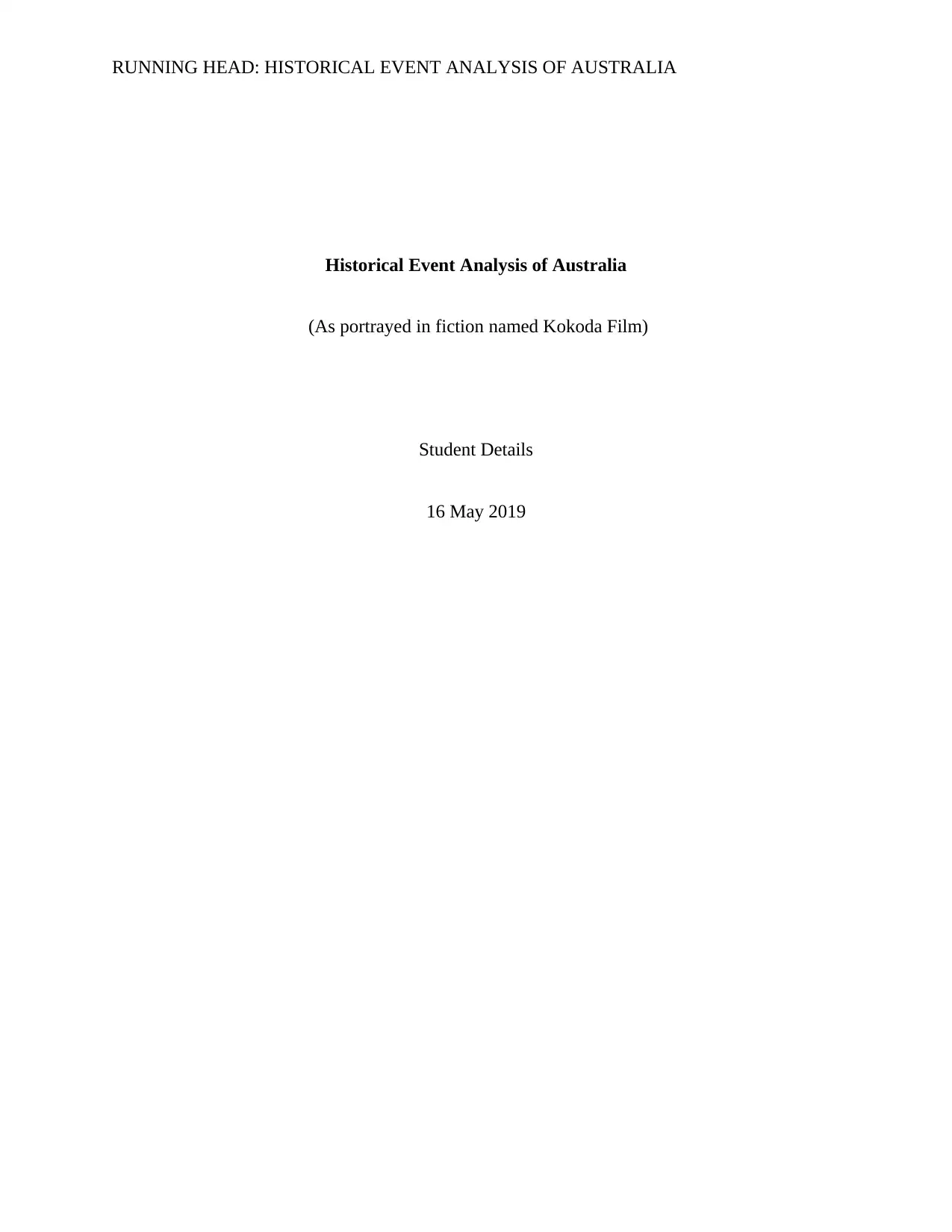
RUNNING HEAD: HISTORICAL EVENT ANALYSIS OF AUSTRALIA
Historical Event Analysis of Australia
(As portrayed in fiction named Kokoda Film)
Student Details
16 May 2019
Historical Event Analysis of Australia
(As portrayed in fiction named Kokoda Film)
Student Details
16 May 2019
Secure Best Marks with AI Grader
Need help grading? Try our AI Grader for instant feedback on your assignments.
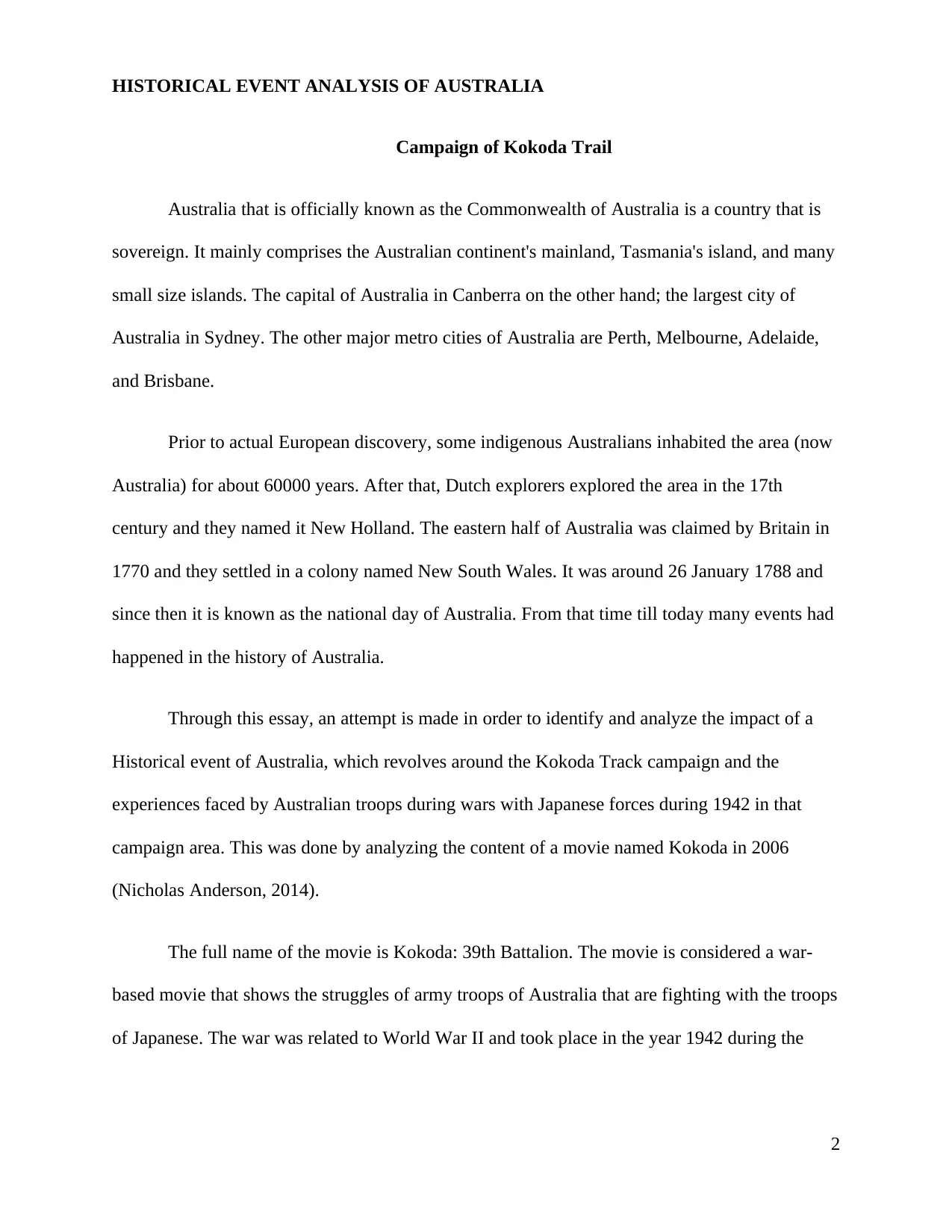
HISTORICAL EVENT ANALYSIS OF AUSTRALIA
Campaign of Kokoda Trail
Australia that is officially known as the Commonwealth of Australia is a country that is
sovereign. It mainly comprises the Australian continent's mainland, Tasmania's island, and many
small size islands. The capital of Australia in Canberra on the other hand; the largest city of
Australia in Sydney. The other major metro cities of Australia are Perth, Melbourne, Adelaide,
and Brisbane.
Prior to actual European discovery, some indigenous Australians inhabited the area (now
Australia) for about 60000 years. After that, Dutch explorers explored the area in the 17th
century and they named it New Holland. The eastern half of Australia was claimed by Britain in
1770 and they settled in a colony named New South Wales. It was around 26 January 1788 and
since then it is known as the national day of Australia. From that time till today many events had
happened in the history of Australia.
Through this essay, an attempt is made in order to identify and analyze the impact of a
Historical event of Australia, which revolves around the Kokoda Track campaign and the
experiences faced by Australian troops during wars with Japanese forces during 1942 in that
campaign area. This was done by analyzing the content of a movie named Kokoda in 2006
(Nicholas Anderson, 2014).
The full name of the movie is Kokoda: 39th Battalion. The movie is considered a war-
based movie that shows the struggles of army troops of Australia that are fighting with the troops
of Japanese. The war was related to World War II and took place in the year 1942 during the
2
Campaign of Kokoda Trail
Australia that is officially known as the Commonwealth of Australia is a country that is
sovereign. It mainly comprises the Australian continent's mainland, Tasmania's island, and many
small size islands. The capital of Australia in Canberra on the other hand; the largest city of
Australia in Sydney. The other major metro cities of Australia are Perth, Melbourne, Adelaide,
and Brisbane.
Prior to actual European discovery, some indigenous Australians inhabited the area (now
Australia) for about 60000 years. After that, Dutch explorers explored the area in the 17th
century and they named it New Holland. The eastern half of Australia was claimed by Britain in
1770 and they settled in a colony named New South Wales. It was around 26 January 1788 and
since then it is known as the national day of Australia. From that time till today many events had
happened in the history of Australia.
Through this essay, an attempt is made in order to identify and analyze the impact of a
Historical event of Australia, which revolves around the Kokoda Track campaign and the
experiences faced by Australian troops during wars with Japanese forces during 1942 in that
campaign area. This was done by analyzing the content of a movie named Kokoda in 2006
(Nicholas Anderson, 2014).
The full name of the movie is Kokoda: 39th Battalion. The movie is considered a war-
based movie that shows the struggles of army troops of Australia that are fighting with the troops
of Japanese. The war was related to World War II and took place in the year 1942 during the
2

HISTORICAL EVENT ANALYSIS OF AUSTRALIA
campaign of Kokoda. Alister Grierson and John Lonie write the movie on the other hand directed
by Alister Grierson.
This essay is going to analyze the events of the selected movie and going to critically
analyze it in order to identify and understand the geographical and historical events taking place
at that time. It will also try to evaluate the effectiveness of involved morality and ethics in the
involved historical issue.
The storyline of this Kokoda film was completely based on the above-mentioned issue in
the history of Australia and it also has shown the struggle and victory of Australian troops that
were undertrained and was also under provisioned to send for such battles. This movie showed
various historical elements of Australia present at that time. It also showed the structure of
geographies of Australia during that century and year. This movie motivates individuals to have
the most patriotism in their elements based on cultural morals and ethics (Nathan Wise, 2014).
The Historical event shown in the movie is such an event that still remains in the hearts
of Australian people and motivates them to stand up and work for their country. The historical
event was that in the war of 1942 the time when Singapore falls down and Australia was on the
edge of losing. They nearly lost the whole division as they were captured and the rest of the crew
was fighting in North Africa with Axis forces. Due to this, Australia was only left with
militiamen and conscripts and they were not considered fit for combat. They were called as
Chocos as they believed to melt away in the battle if they will fight. They were just appointed to
do menial tasks (Peter Williams, 2012).
3
campaign of Kokoda. Alister Grierson and John Lonie write the movie on the other hand directed
by Alister Grierson.
This essay is going to analyze the events of the selected movie and going to critically
analyze it in order to identify and understand the geographical and historical events taking place
at that time. It will also try to evaluate the effectiveness of involved morality and ethics in the
involved historical issue.
The storyline of this Kokoda film was completely based on the above-mentioned issue in
the history of Australia and it also has shown the struggle and victory of Australian troops that
were undertrained and was also under provisioned to send for such battles. This movie showed
various historical elements of Australia present at that time. It also showed the structure of
geographies of Australia during that century and year. This movie motivates individuals to have
the most patriotism in their elements based on cultural morals and ethics (Nathan Wise, 2014).
The Historical event shown in the movie is such an event that still remains in the hearts
of Australian people and motivates them to stand up and work for their country. The historical
event was that in the war of 1942 the time when Singapore falls down and Australia was on the
edge of losing. They nearly lost the whole division as they were captured and the rest of the crew
was fighting in North Africa with Axis forces. Due to this, Australia was only left with
militiamen and conscripts and they were not considered fit for combat. They were called as
Chocos as they believed to melt away in the battle if they will fight. They were just appointed to
do menial tasks (Peter Williams, 2012).
3
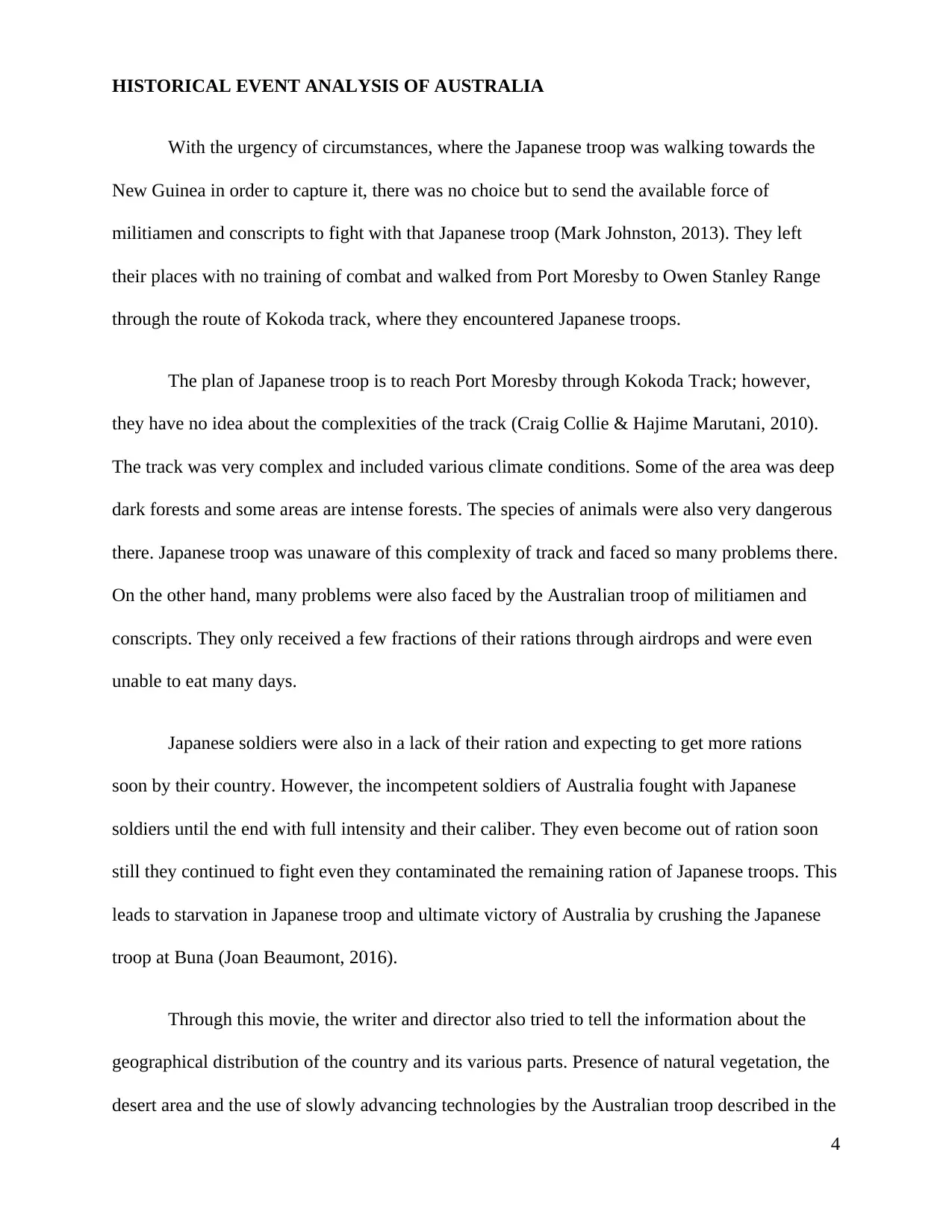
HISTORICAL EVENT ANALYSIS OF AUSTRALIA
With the urgency of circumstances, where the Japanese troop was walking towards the
New Guinea in order to capture it, there was no choice but to send the available force of
militiamen and conscripts to fight with that Japanese troop (Mark Johnston, 2013). They left
their places with no training of combat and walked from Port Moresby to Owen Stanley Range
through the route of Kokoda track, where they encountered Japanese troops.
The plan of Japanese troop is to reach Port Moresby through Kokoda Track; however,
they have no idea about the complexities of the track (Craig Collie & Hajime Marutani, 2010).
The track was very complex and included various climate conditions. Some of the area was deep
dark forests and some areas are intense forests. The species of animals were also very dangerous
there. Japanese troop was unaware of this complexity of track and faced so many problems there.
On the other hand, many problems were also faced by the Australian troop of militiamen and
conscripts. They only received a few fractions of their rations through airdrops and were even
unable to eat many days.
Japanese soldiers were also in a lack of their ration and expecting to get more rations
soon by their country. However, the incompetent soldiers of Australia fought with Japanese
soldiers until the end with full intensity and their caliber. They even become out of ration soon
still they continued to fight even they contaminated the remaining ration of Japanese troops. This
leads to starvation in Japanese troop and ultimate victory of Australia by crushing the Japanese
troop at Buna (Joan Beaumont, 2016).
Through this movie, the writer and director also tried to tell the information about the
geographical distribution of the country and its various parts. Presence of natural vegetation, the
desert area and the use of slowly advancing technologies by the Australian troop described in the
4
With the urgency of circumstances, where the Japanese troop was walking towards the
New Guinea in order to capture it, there was no choice but to send the available force of
militiamen and conscripts to fight with that Japanese troop (Mark Johnston, 2013). They left
their places with no training of combat and walked from Port Moresby to Owen Stanley Range
through the route of Kokoda track, where they encountered Japanese troops.
The plan of Japanese troop is to reach Port Moresby through Kokoda Track; however,
they have no idea about the complexities of the track (Craig Collie & Hajime Marutani, 2010).
The track was very complex and included various climate conditions. Some of the area was deep
dark forests and some areas are intense forests. The species of animals were also very dangerous
there. Japanese troop was unaware of this complexity of track and faced so many problems there.
On the other hand, many problems were also faced by the Australian troop of militiamen and
conscripts. They only received a few fractions of their rations through airdrops and were even
unable to eat many days.
Japanese soldiers were also in a lack of their ration and expecting to get more rations
soon by their country. However, the incompetent soldiers of Australia fought with Japanese
soldiers until the end with full intensity and their caliber. They even become out of ration soon
still they continued to fight even they contaminated the remaining ration of Japanese troops. This
leads to starvation in Japanese troop and ultimate victory of Australia by crushing the Japanese
troop at Buna (Joan Beaumont, 2016).
Through this movie, the writer and director also tried to tell the information about the
geographical distribution of the country and its various parts. Presence of natural vegetation, the
desert area and the use of slowly advancing technologies by the Australian troop described in the
4
Secure Best Marks with AI Grader
Need help grading? Try our AI Grader for instant feedback on your assignments.
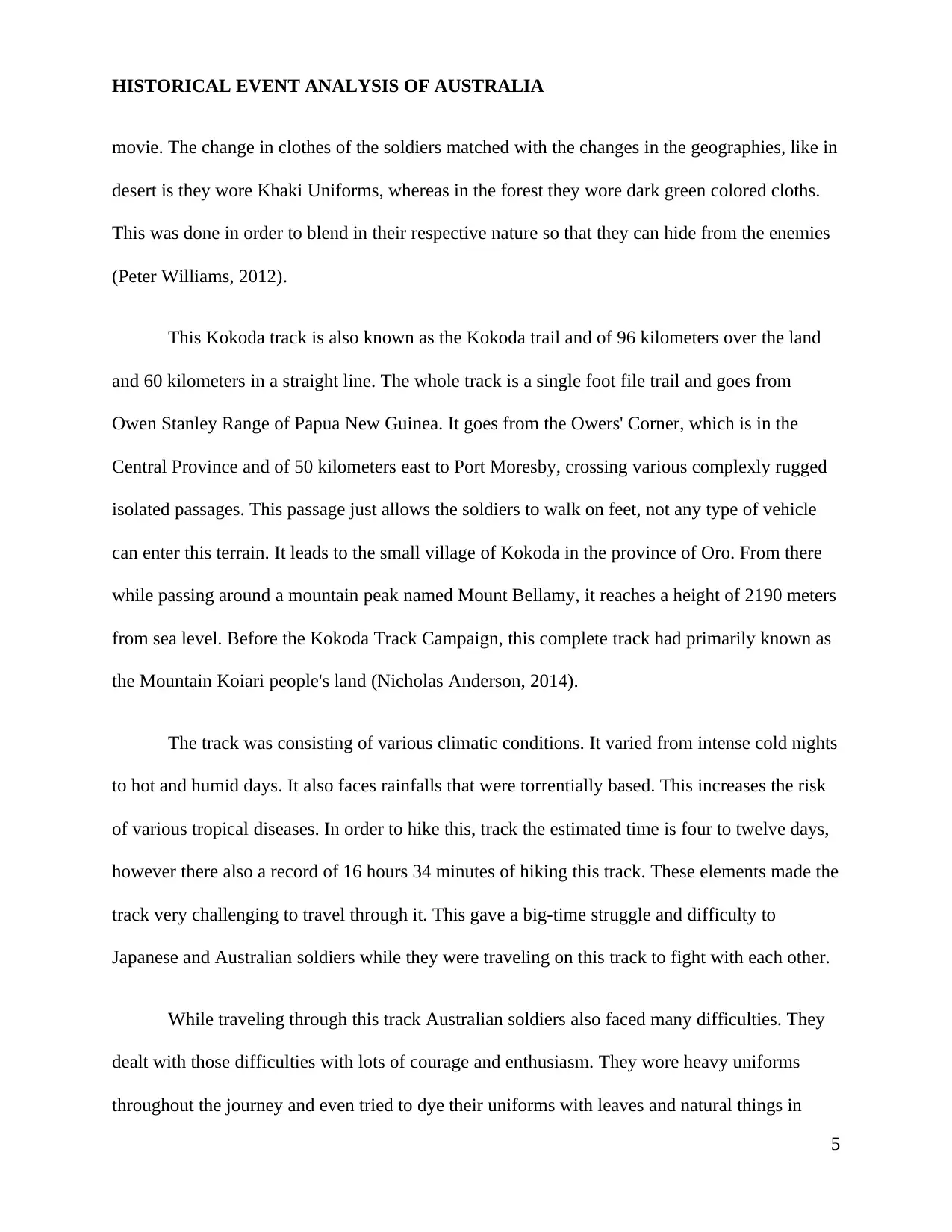
HISTORICAL EVENT ANALYSIS OF AUSTRALIA
movie. The change in clothes of the soldiers matched with the changes in the geographies, like in
desert is they wore Khaki Uniforms, whereas in the forest they wore dark green colored cloths.
This was done in order to blend in their respective nature so that they can hide from the enemies
(Peter Williams, 2012).
This Kokoda track is also known as the Kokoda trail and of 96 kilometers over the land
and 60 kilometers in a straight line. The whole track is a single foot file trail and goes from
Owen Stanley Range of Papua New Guinea. It goes from the Owers' Corner, which is in the
Central Province and of 50 kilometers east to Port Moresby, crossing various complexly rugged
isolated passages. This passage just allows the soldiers to walk on feet, not any type of vehicle
can enter this terrain. It leads to the small village of Kokoda in the province of Oro. From there
while passing around a mountain peak named Mount Bellamy, it reaches a height of 2190 meters
from sea level. Before the Kokoda Track Campaign, this complete track had primarily known as
the Mountain Koiari people's land (Nicholas Anderson, 2014).
The track was consisting of various climatic conditions. It varied from intense cold nights
to hot and humid days. It also faces rainfalls that were torrentially based. This increases the risk
of various tropical diseases. In order to hike this, track the estimated time is four to twelve days,
however there also a record of 16 hours 34 minutes of hiking this track. These elements made the
track very challenging to travel through it. This gave a big-time struggle and difficulty to
Japanese and Australian soldiers while they were traveling on this track to fight with each other.
While traveling through this track Australian soldiers also faced many difficulties. They
dealt with those difficulties with lots of courage and enthusiasm. They wore heavy uniforms
throughout the journey and even tried to dye their uniforms with leaves and natural things in
5
movie. The change in clothes of the soldiers matched with the changes in the geographies, like in
desert is they wore Khaki Uniforms, whereas in the forest they wore dark green colored cloths.
This was done in order to blend in their respective nature so that they can hide from the enemies
(Peter Williams, 2012).
This Kokoda track is also known as the Kokoda trail and of 96 kilometers over the land
and 60 kilometers in a straight line. The whole track is a single foot file trail and goes from
Owen Stanley Range of Papua New Guinea. It goes from the Owers' Corner, which is in the
Central Province and of 50 kilometers east to Port Moresby, crossing various complexly rugged
isolated passages. This passage just allows the soldiers to walk on feet, not any type of vehicle
can enter this terrain. It leads to the small village of Kokoda in the province of Oro. From there
while passing around a mountain peak named Mount Bellamy, it reaches a height of 2190 meters
from sea level. Before the Kokoda Track Campaign, this complete track had primarily known as
the Mountain Koiari people's land (Nicholas Anderson, 2014).
The track was consisting of various climatic conditions. It varied from intense cold nights
to hot and humid days. It also faces rainfalls that were torrentially based. This increases the risk
of various tropical diseases. In order to hike this, track the estimated time is four to twelve days,
however there also a record of 16 hours 34 minutes of hiking this track. These elements made the
track very challenging to travel through it. This gave a big-time struggle and difficulty to
Japanese and Australian soldiers while they were traveling on this track to fight with each other.
While traveling through this track Australian soldiers also faced many difficulties. They
dealt with those difficulties with lots of courage and enthusiasm. They wore heavy uniforms
throughout the journey and even tried to dye their uniforms with leaves and natural things in
5
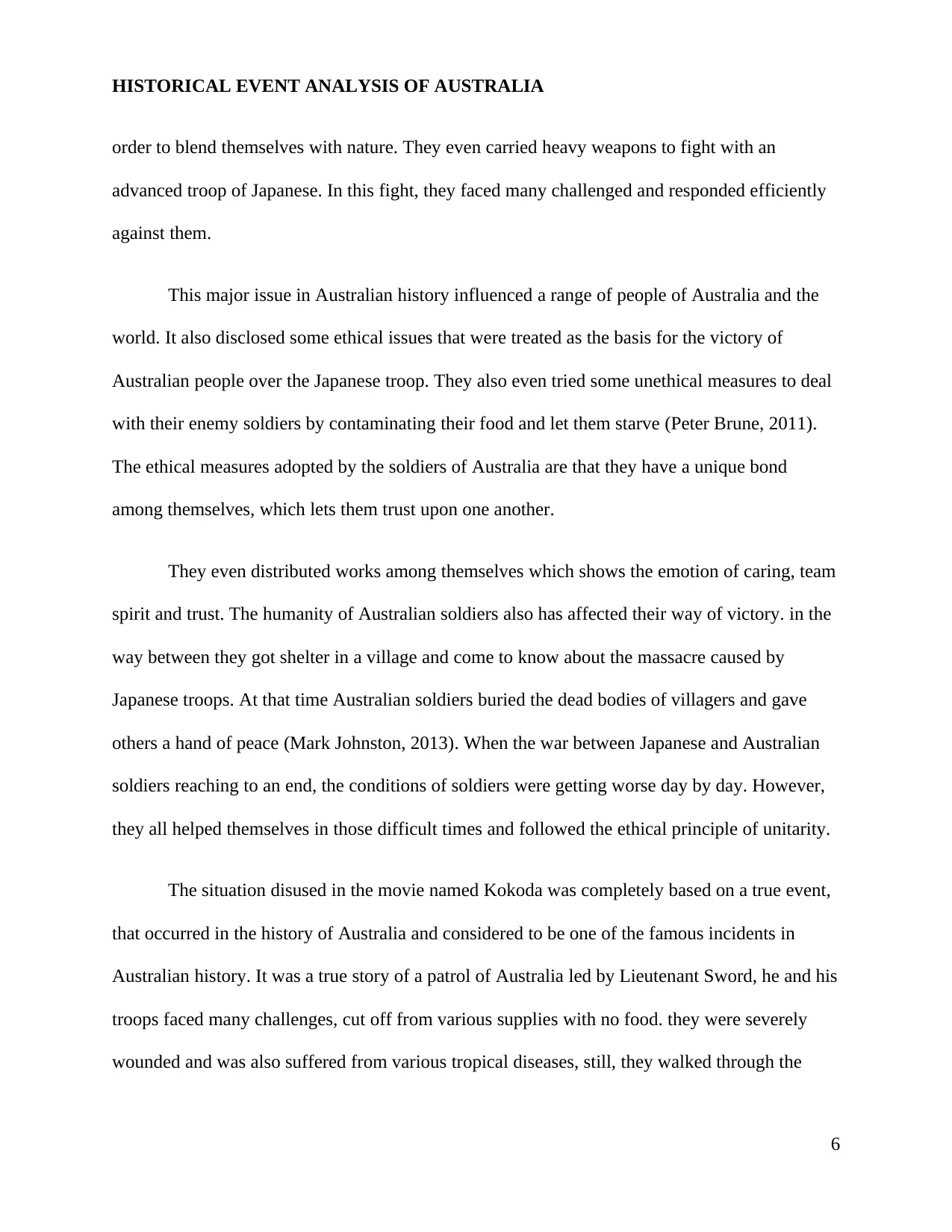
HISTORICAL EVENT ANALYSIS OF AUSTRALIA
order to blend themselves with nature. They even carried heavy weapons to fight with an
advanced troop of Japanese. In this fight, they faced many challenged and responded efficiently
against them.
This major issue in Australian history influenced a range of people of Australia and the
world. It also disclosed some ethical issues that were treated as the basis for the victory of
Australian people over the Japanese troop. They also even tried some unethical measures to deal
with their enemy soldiers by contaminating their food and let them starve (Peter Brune, 2011).
The ethical measures adopted by the soldiers of Australia are that they have a unique bond
among themselves, which lets them trust upon one another.
They even distributed works among themselves which shows the emotion of caring, team
spirit and trust. The humanity of Australian soldiers also has affected their way of victory. in the
way between they got shelter in a village and come to know about the massacre caused by
Japanese troops. At that time Australian soldiers buried the dead bodies of villagers and gave
others a hand of peace (Mark Johnston, 2013). When the war between Japanese and Australian
soldiers reaching to an end, the conditions of soldiers were getting worse day by day. However,
they all helped themselves in those difficult times and followed the ethical principle of unitarity.
The situation disused in the movie named Kokoda was completely based on a true event,
that occurred in the history of Australia and considered to be one of the famous incidents in
Australian history. It was a true story of a patrol of Australia led by Lieutenant Sword, he and his
troops faced many challenges, cut off from various supplies with no food. they were severely
wounded and was also suffered from various tropical diseases, still, they walked through the
6
order to blend themselves with nature. They even carried heavy weapons to fight with an
advanced troop of Japanese. In this fight, they faced many challenged and responded efficiently
against them.
This major issue in Australian history influenced a range of people of Australia and the
world. It also disclosed some ethical issues that were treated as the basis for the victory of
Australian people over the Japanese troop. They also even tried some unethical measures to deal
with their enemy soldiers by contaminating their food and let them starve (Peter Brune, 2011).
The ethical measures adopted by the soldiers of Australia are that they have a unique bond
among themselves, which lets them trust upon one another.
They even distributed works among themselves which shows the emotion of caring, team
spirit and trust. The humanity of Australian soldiers also has affected their way of victory. in the
way between they got shelter in a village and come to know about the massacre caused by
Japanese troops. At that time Australian soldiers buried the dead bodies of villagers and gave
others a hand of peace (Mark Johnston, 2013). When the war between Japanese and Australian
soldiers reaching to an end, the conditions of soldiers were getting worse day by day. However,
they all helped themselves in those difficult times and followed the ethical principle of unitarity.
The situation disused in the movie named Kokoda was completely based on a true event,
that occurred in the history of Australia and considered to be one of the famous incidents in
Australian history. It was a true story of a patrol of Australia led by Lieutenant Sword, he and his
troops faced many challenges, cut off from various supplies with no food. they were severely
wounded and was also suffered from various tropical diseases, still, they walked through the
6
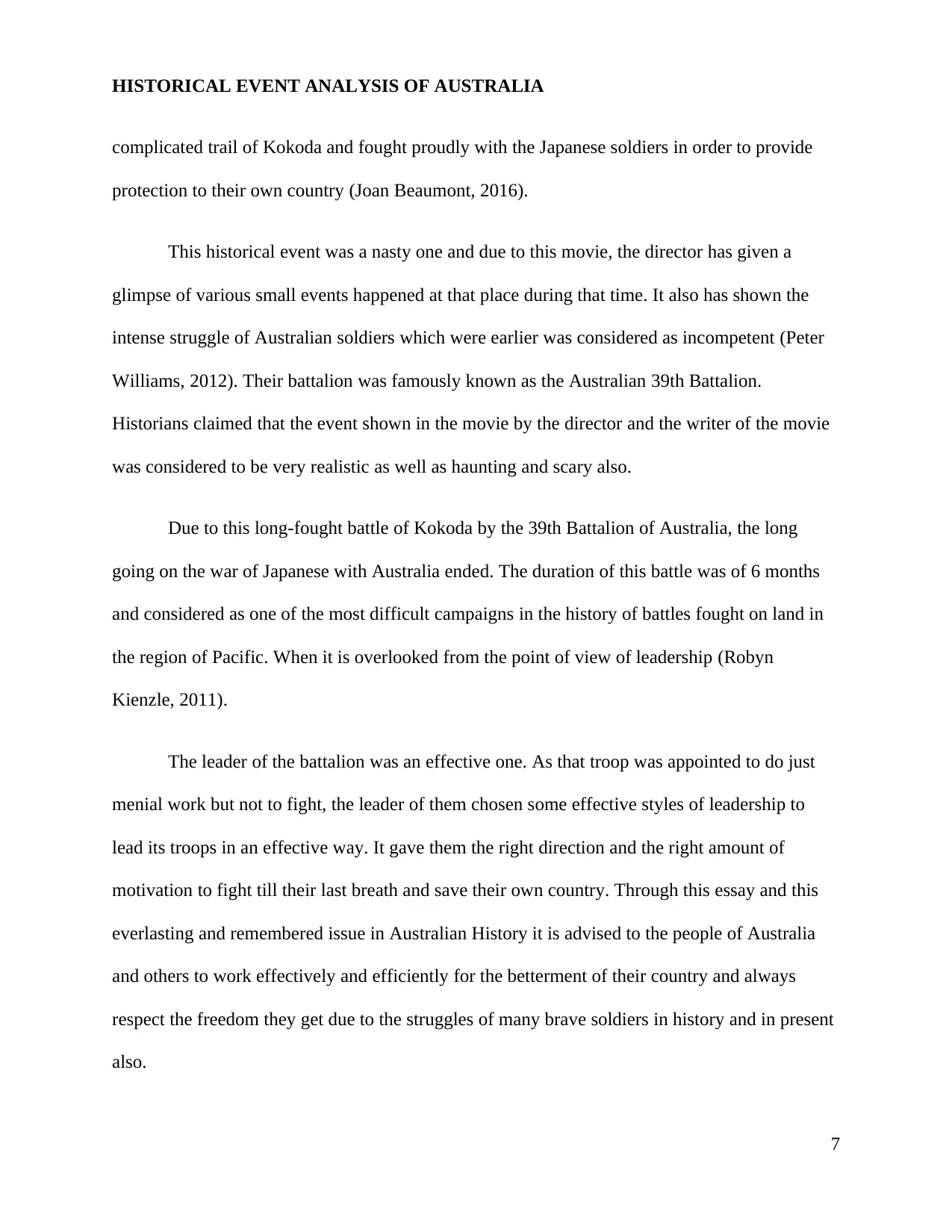
HISTORICAL EVENT ANALYSIS OF AUSTRALIA
complicated trail of Kokoda and fought proudly with the Japanese soldiers in order to provide
protection to their own country (Joan Beaumont, 2016).
This historical event was a nasty one and due to this movie, the director has given a
glimpse of various small events happened at that place during that time. It also has shown the
intense struggle of Australian soldiers which were earlier was considered as incompetent (Peter
Williams, 2012). Their battalion was famously known as the Australian 39th Battalion.
Historians claimed that the event shown in the movie by the director and the writer of the movie
was considered to be very realistic as well as haunting and scary also.
Due to this long-fought battle of Kokoda by the 39th Battalion of Australia, the long
going on the war of Japanese with Australia ended. The duration of this battle was of 6 months
and considered as one of the most difficult campaigns in the history of battles fought on land in
the region of Pacific. When it is overlooked from the point of view of leadership (Robyn
Kienzle, 2011).
The leader of the battalion was an effective one. As that troop was appointed to do just
menial work but not to fight, the leader of them chosen some effective styles of leadership to
lead its troops in an effective way. It gave them the right direction and the right amount of
motivation to fight till their last breath and save their own country. Through this essay and this
everlasting and remembered issue in Australian History it is advised to the people of Australia
and others to work effectively and efficiently for the betterment of their country and always
respect the freedom they get due to the struggles of many brave soldiers in history and in present
also.
7
complicated trail of Kokoda and fought proudly with the Japanese soldiers in order to provide
protection to their own country (Joan Beaumont, 2016).
This historical event was a nasty one and due to this movie, the director has given a
glimpse of various small events happened at that place during that time. It also has shown the
intense struggle of Australian soldiers which were earlier was considered as incompetent (Peter
Williams, 2012). Their battalion was famously known as the Australian 39th Battalion.
Historians claimed that the event shown in the movie by the director and the writer of the movie
was considered to be very realistic as well as haunting and scary also.
Due to this long-fought battle of Kokoda by the 39th Battalion of Australia, the long
going on the war of Japanese with Australia ended. The duration of this battle was of 6 months
and considered as one of the most difficult campaigns in the history of battles fought on land in
the region of Pacific. When it is overlooked from the point of view of leadership (Robyn
Kienzle, 2011).
The leader of the battalion was an effective one. As that troop was appointed to do just
menial work but not to fight, the leader of them chosen some effective styles of leadership to
lead its troops in an effective way. It gave them the right direction and the right amount of
motivation to fight till their last breath and save their own country. Through this essay and this
everlasting and remembered issue in Australian History it is advised to the people of Australia
and others to work effectively and efficiently for the betterment of their country and always
respect the freedom they get due to the struggles of many brave soldiers in history and in present
also.
7
Paraphrase This Document
Need a fresh take? Get an instant paraphrase of this document with our AI Paraphraser
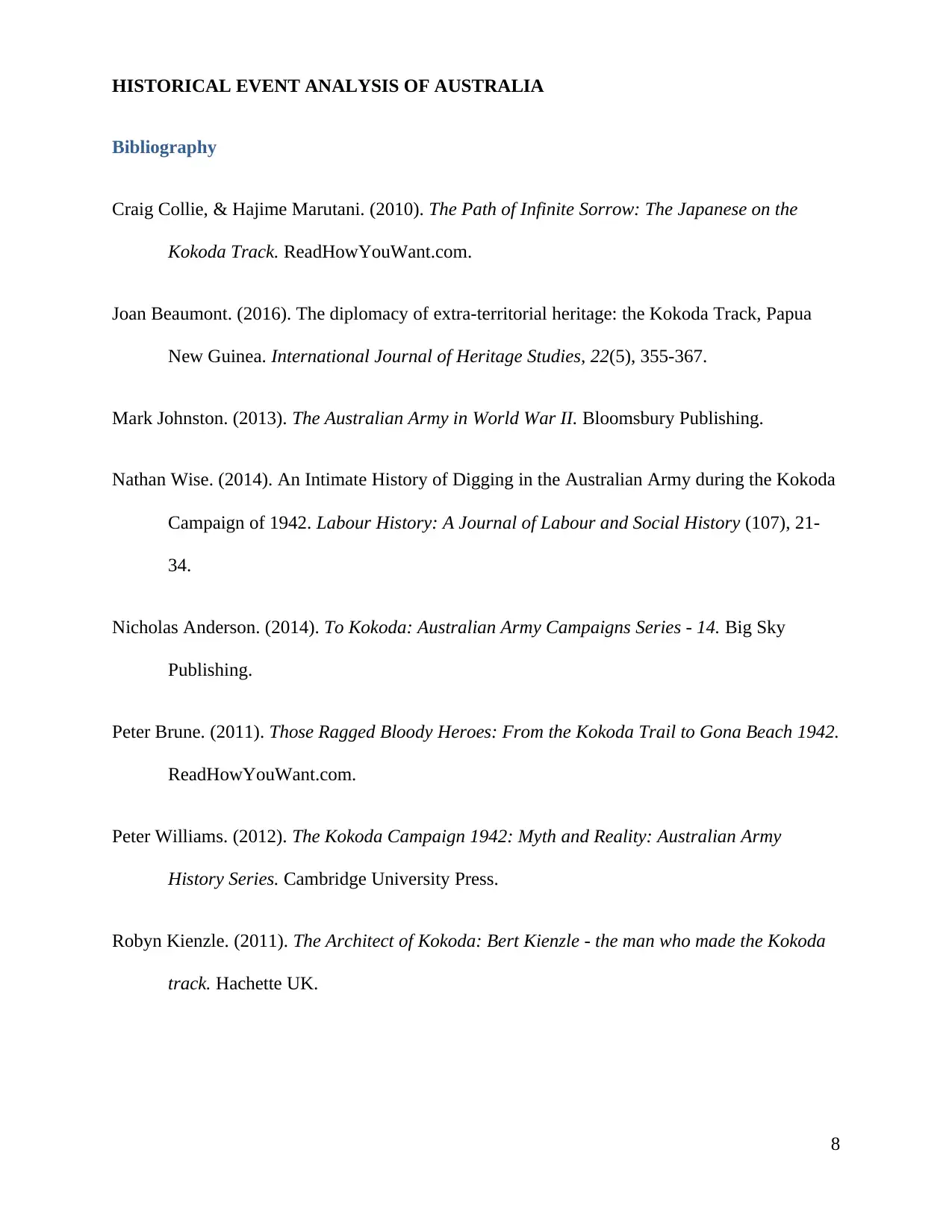
HISTORICAL EVENT ANALYSIS OF AUSTRALIA
Bibliography
Craig Collie, & Hajime Marutani. (2010). The Path of Infinite Sorrow: The Japanese on the
Kokoda Track. ReadHowYouWant.com.
Joan Beaumont. (2016). The diplomacy of extra-territorial heritage: the Kokoda Track, Papua
New Guinea. International Journal of Heritage Studies, 22(5), 355-367.
Mark Johnston. (2013). The Australian Army in World War II. Bloomsbury Publishing.
Nathan Wise. (2014). An Intimate History of Digging in the Australian Army during the Kokoda
Campaign of 1942. Labour History: A Journal of Labour and Social History (107), 21-
34.
Nicholas Anderson. (2014). To Kokoda: Australian Army Campaigns Series - 14. Big Sky
Publishing.
Peter Brune. (2011). Those Ragged Bloody Heroes: From the Kokoda Trail to Gona Beach 1942.
ReadHowYouWant.com.
Peter Williams. (2012). The Kokoda Campaign 1942: Myth and Reality: Australian Army
History Series. Cambridge University Press.
Robyn Kienzle. (2011). The Architect of Kokoda: Bert Kienzle - the man who made the Kokoda
track. Hachette UK.
8
Bibliography
Craig Collie, & Hajime Marutani. (2010). The Path of Infinite Sorrow: The Japanese on the
Kokoda Track. ReadHowYouWant.com.
Joan Beaumont. (2016). The diplomacy of extra-territorial heritage: the Kokoda Track, Papua
New Guinea. International Journal of Heritage Studies, 22(5), 355-367.
Mark Johnston. (2013). The Australian Army in World War II. Bloomsbury Publishing.
Nathan Wise. (2014). An Intimate History of Digging in the Australian Army during the Kokoda
Campaign of 1942. Labour History: A Journal of Labour and Social History (107), 21-
34.
Nicholas Anderson. (2014). To Kokoda: Australian Army Campaigns Series - 14. Big Sky
Publishing.
Peter Brune. (2011). Those Ragged Bloody Heroes: From the Kokoda Trail to Gona Beach 1942.
ReadHowYouWant.com.
Peter Williams. (2012). The Kokoda Campaign 1942: Myth and Reality: Australian Army
History Series. Cambridge University Press.
Robyn Kienzle. (2011). The Architect of Kokoda: Bert Kienzle - the man who made the Kokoda
track. Hachette UK.
8
1 out of 8
Related Documents
Your All-in-One AI-Powered Toolkit for Academic Success.
+13062052269
info@desklib.com
Available 24*7 on WhatsApp / Email
![[object Object]](/_next/static/media/star-bottom.7253800d.svg)
Unlock your academic potential
© 2024 | Zucol Services PVT LTD | All rights reserved.
